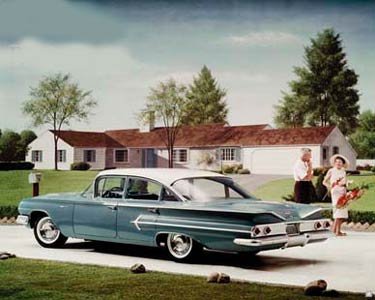
The 1960 Chevrolet Bel Air was a no frills model which cost a mere $2500.
My dad bought one of the above Chevrolets brand new in 1960. He eventually passed it along to me and it was still running in 1971 with 150,000 and I got something like $500 for it when I sold it upon returning to Yale.
In the pre-WWII period, you could go to Morris Garages (MG) in Oxford, England and have a custom automobile, your choice of engine, your choice of body run up for you.
Eric Peters explains how it came about that today’s automobiles cost more than working men’s houses did when I was a boy, and why buyers’ choices shrink every year. Our most recent BMW came lacking any sort of spare tire whatsoever. Someone in the federal bureaucracy decided that you could always just phone for roadside assistance when you got a flat and thought that eliminating the spare tire would reduce automobile’s rolling weight and save energy. “So let it be written, so let it be done.” Auto companies, like BMW, happily clicked their heels, fell into line, and stopped providing spare tires.
In this economy, can anyone seriously doubt that there is a market for simple, reliable – and inexpensive – transportation?
In any case, why not let the market operate? Why not allow (god, how I hate that term) Tata or Cherry (or whomever) to offer their basic, low-cost cars for sale here – and see whether people are interested?
You and I know why this will not be allowed, of course. Precisely because people would buy such cars – and that would impose pressure on the industry at large to simplify their offerings, too – and reduce the cost.
Can’t have that.
It is critical to keep people perpetually in debt. Why allow them to buy a new $6,000 car outright – or pay it off in two or three years (as was common once – and within living memory of any person older than 40) when you can effectively force them to buy a $30,000 car (the average price paid for a new vehicle as of last year) and sign them up for 5 or 6 years of payments? And force them to spend $1,000 annually to insure it, too?
That’s the truth of the thing.
It’s not about “safety†– or any other such altruistic palaver.broke picture
It is about power – control.
And, of course, money.
I’ve written about air bags before. Classic example, so worth repeating. They were first put on the market – in the early-mid 1970s by both GM and Chrysler – as optional equipment that people could buy. Or not.
Most people chose not to buy.
Not because they were cavalier risk junkies – as people such as myself are often characterized by the Air Bag Nazis. But simply because the cost of the air bags was prohibitive. They added as much to the bottom line price of a car (this is back in the ’70s) as air conditioning did – and AC was just about the most expensive option you could buy in those days.
So, they failed in the marketplace. Which is why the car companies worked with the government to see them made mandatory. Now you cannot say no to air bags. And to many other “features†you may not want in a car. These features are not necessarily bad. The question is – or ought to be: Can you afford them? Many people cannot. Hence the now-common six-year payment plan. Soon – count on it – to be expanded to seven years.
Then eight. …
The problem is most people are not outraged about this. They don’t seem to mind being told what they’ll buy – nor how much they’ll pay for it. They’d probably be annoyed if their next door neighbor marched over one day and told them they had to drive this type of car – and weren’t going to be allowed to drive that type of car. Their first reaction would be open-mouthed bewilderment. Their second reaction would be: Who the hell do you think you are? And then: Get the hell off my property – and mind your own business.
Right?
And yet, most people will accept the same damn thing when it’s done at once or twice remove, by “regulation†and in a city, far, far away.
Read the whole thing.





